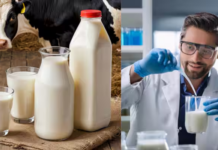New Delhi, October 15, 2022: In India, dairy and dairy products are staples in every home. In India, milk plays an important role in both daily life and religious rites. In addition to this, millions of people, especially women, in rural regions rely on the dairy industry for their livelihood. It’s crucial if a farmer wants to increase his earnings by 50%.
Beginnings were Slow
For several years during the 1950s and 1960s, yearly output growth in the nation’s dairy market was negative.
In the 1970’s, Operation Flood brought cooperatives into the dairy industry with the goals of increasing milk output, boosting rural income, and providing customers with transparent pricing. It was made so that donated milk products from other countries could be used in a way that would help the local dairy industry grow.
The objectives of Operation Flood were as follows:
- To give each city’s liquid milk system a chance to change and get a bigger share of the market.
- Identifying and meeting the demands of milk producers and purchasers so that customers’ preferences may be met economically and farmers can get a higher proportion of the price paid by consumers for their milk.
- Encourage investment in long-term viable dairying and cattle expansion.
- To make sure there are enough workers to handle all parts of the project.
The surplus
Since 1998, India has had the world’s largest bovine population and has been the world’s top milk producer. From 1950-51 to 2017-18, India’s milk production increased from 17 to 176.4 million metric tonnes (MT).
Dairy farming has been more important in improving the economic prospects of marginal and female farmers, and is now relied on by millions of rural people as either a major or secondary source of income.
Yet the challenges remain.
Small-scale, dispersed, and unorganized milk-animal owners; low productivity; inadequate and improper animal care; a lack of professional management; a dearth of basic infrastructure for the provision of production inputs and services; and an inadequacy of basic infrastructure for the sourcing, transportation, handling, and marketing of milk are a few of the challenges of the Indian dairy industry. Most milk comes from cows and goats kept by poor farmers and city people who don’t have access to pasture.
Mixed-crop and livestock farms are common, and most milk cows are fed agricultural by-products and residues, which have very low opportunity costs. This means the dairy industry faces more challenges according to the reports published in cxotoday.com.
The government has their support
Milk production and bovine productivity have been significantly increased as a result of schemes like the Rashtriya Gokul Mission (RGM), the National Programme for Dairy Development (NPDD), the Dairy Infrastructure Development Fund (DIF), and the Supporting Dairy Cooperatives & Farmer Producer Organizations (SDCFPO), which have helped to meet the rising demand for dairy and make dairy farming more financially rewarding for rural farmers. State agencies like the state cooperative dairy federations and the District Cooperative Milk Producers’ Union have been at the forefront of creating and improving the technology needed to make high-quality milk and to buy, process, and sell milk and milk products.
The Current Scenario
Due to the country’s improving economy, more and more Indians now have disposable incomes that may be spent on goods like dairy. A further factor contributing to the expansion of the food and drink market is the increasing prevalence of dairy product use. One of the most important factors boosting the dairy industry in India is the introduction of new harvesting techniques that have increased output. The nation has made it a priority to increase its productivity per animal by implementing a number of different policies. The Indian government set up the National Dairy Programme to increase milk production and make it easier for farmers to get milk, which increased demand even more.
Domestic and foreign private firms are also driving growth in India’s dairy business today. Private enterprises like these provide a diverse selection of goods to meet the needs of their customers. Customers are giving greater attention to high-end dairy products, including cheese, probiotic drinks, yoghurt, etc. Indians eat a lot of dairy products because they are high in calcium and have other important nutrients. This has increased demand and grown the dairy industry.
Future Trends to Keep an Eye On
The dairy industry in India is aiming to build a $355 billion industry by 2025. In the future, the following trends can be witnessed:
Direct-to-Consumer Deliveries: There will be an increase in the number of businesses that provide express direct-to-consumer deliveries of dairy and dairy products. These businesses will allow consumers to place orders directly with the dairy supplier.
Encourage digital banking: Promoting digital banking, digital payments, and fintech would help the livestock industry as a whole by making it faster for farmers to get paid for milk and other services they provide.
Infrastructure: Throughout the whole of the supply chain, milk and other items that are directly associated with it need to be kept at the correct temperature. With the help of a number of government programs, the dairy industry in India is putting in place the right infrastructure to keep a smooth supply chain all the way to the consumers’ doors.
Digitalizing the Local Store: Bringing the local shop onto the digital platform is one of the developments that can be anticipated in the future. This will enable speedier door-step delivery of dairy goods.

































